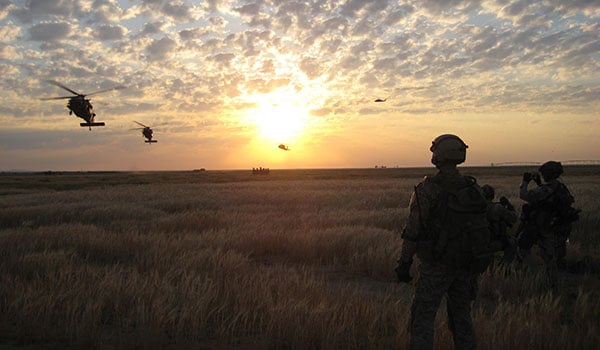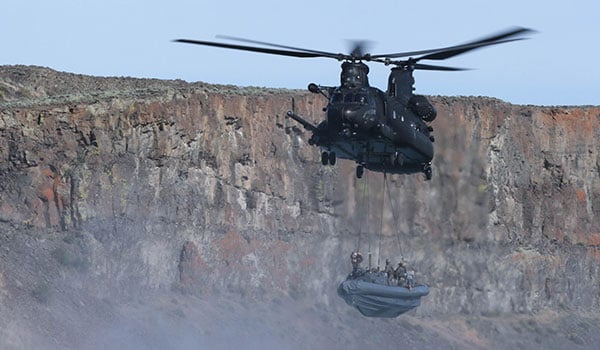
160th Special Operations Aviation Regiment (Airborne) / By COL Michael J. Hertzendorf and MAJ Roger P. Waleski: On any given day the Regiment’s professional aircrews, support staffs, and maintenance personnel, operate around the globe in austere and uncertain environments accomplishing a multitude of diverse Special Operations Forces (SOF) missions. These dynamic full spectrum SOF operations support the Global SOF “Network,” a U.S. Special Operations Command (USSOCOM) initiative to globally link SOF, the Interagency, Allies, and our DoD partners.

MH-60M Black Hawks assigned to the 1st Battalion, 160th Special Operations Aviation Regiment (Airborne) prepare to extract Marines from the Marine Special Operations Regiment (MARSOC). / U.S. ARMY PHOTO
Ranging from complex, long range, precision strike missions to operations in ambiguous environments supporting the full spectrum of special operations and unconventional warfare, missions include rotary wing assault, rotary wing attack, intelligence, surveillance, and reconnaissance (ISR), as well as, Aviation Foreign Internal Defense (AvFID). These diverse, unique capabilities require not just ready platforms but, proficient, fit, disciplined, and motivated Soldiers and leaders who are relentlessly focused, and dedicated to supporting our Nation’s elite SOF (the Customer) and our National strategic objectives.
Preparing the Force
To support the Network, the 160th develops agile leaders who thrive and can win in today’s complex environment. The Regiment Leader Development Program requires commanders to incorporate personal and professional development training continually to all ranks within the formation. The intent of the program is to improve professional skills, leadership skills, personal growth, and expand a Night Stalker’s knowledge base within the scope of current and future responsibilities.
The Regiment also creates agile leaders by empowering our junior officers, warrant officers, and NCOs. It is common for young field grade and company grade officers to lead Special Operations Aviation (SOA) assets while supporting overseas Joint SOF training missions and exercises. These opportunities allow our junior leaders to manage risk outside of combat and make difficult operational decisions within the framework of the exercises. The combination of a disciplined leader development program coupled with real world practical experience allows our air mission commanders (AMC) and fully mission qualified (FMQ) aircrew members to make quick, prudent tactical decisions while gaining an appreciation of the larger complexities facing senior commanders and staffs.
The Regiment routinely trains expeditionary operations, which require battalion staffs to plan and conduct long-range, complex missions in a setting without a well-established logistical support structure. This forces leaders to work with Joint, Interagency, Intergovernmental, and Multinational (JIIM) partners to synchronize mission enablers to execute SOA missions in austere environments. For example, in November 4/160th SOAR (A) executed a massive, multistate Joint exercise that included elements from the 75th Ranger Regiment, 522nd Special Operations Squadron, DIA Office of Technical Operations, and Marine Air Wing VMGR 352. This highly successful exercise increased interoperability throughout the USSOCOM enterprise while building viable relationships with our interagency partners.

Special Warfare Combatant-craft Crewmen from Special Boat Team 12, stationed at Naval Base Coronado, CA, with the help of aviators from 4th Battalion, 160th Special Operations Aviation Regiment, stationed at Joint Base Lewis-McChord, WA, conducted a Maritime External Air Transportation System (MEATS) training evolution in Moses Lake, WA. MEATS is a way to move a watercraft from a point on land or water to somewhere else using an Army MH-47G Chinook helicopter. The crewmen rig the boat to the helicopter as it hovers above, and then climb a rope ladder to board the helicopter before moving to the final destination, where they will slide down a rope to the boat before the helicopter disconnects the hoist cables./ U.S. ARMY PHOTO BY SGT CHRISTOPHER PROWS, 5TH MOBILE PUBLIC AFFAIRS DET.
COCOM Engagement
Preparing the force ensures the Regiment is ready to execute demanding missions throughout the Combatant Commands, especially in the Central Command (CENTCOM) area of responsibility (AOR) where U.S. SOF remain heavily engaged. In Afghanistan, the Regiment continues to provide precision rotary wing lift, fires, and ISR support to the Special Operations Joint Task Force – Afghanistan (SOJTF-A), NATO-SOF, and Afghan Partner Units conducting combined security and counter terrorism operations. Together, these assets routinely conduct expeditionary assault operations throughout the country in remote locations. These operations continue to enhance the Regiment’s interoperability and interdependence with conventional U.S. Army and Afghan aviation units to meet the large lift requirements associated with combined SOF operations.
The 160th maintains a forward ARSOA package to support CENTCOM requirements and last summer deployed this force into Iraq in response to the growing Da’ish (ISIS) threat. These crews currently support a vast array of SOF and CFLCC-I missions including mobility operations, quick reaction force (QRF) support, casualty evacuation (CASEVAC), and personal recovery (PR) contingencies. Here, the Regiment is well suited to support coalition forces and the Interagency as aircrews have extensive experience conducting multiple diverse missions while operating in the complex JIIM environment.

The Regiment also has the unique opportunity to participate in numerous combined SOF exercises within CENTCOM. This year, aircrews contributed to the multi-national exercise EAGER LION in Jordan and INVINCIBLE SENTRY in Kuwait. Together, these events remain invaluable in building partner nation capacity and improving combined SOF interoperability between allies, all in an effort to counter malevolent state and non-state actors in the region.
In Pacific Command (PACOM), the 160th continues to expand its contributions to the world’s largest geographic combatant command. In FY 14, the Regiment supported five Joint Combined Exchange Training (JCET) and Joint Chiefs of Staff (JCS) exercises in four different countries. These events improved interoperability with our critical regional allies of Australia, Korea, and Thailand while furthering PACOM Theater Security Cooperation Plan objectives. These events provide the Regiment with amazing opportunities to train with theater Joint Special Operations Aviation Commands (JSOACs) and PACOM regionally aligned SOF units including 1st Special Forces Group (Airborne) and Naval Special Warfare Group – One.
During this Fiscal Year, the Regiment will increase its presence in PACOM by conducting a planned 170 days of support during seven JCET and JCS exercises. Unit leaders are taking every opportunity to maximize training opportunities by combining multiple exercises over a single deployment. For example, in April 2015, aircrews supported BALANCE KNIFE and FOAL EAGLE in the Republic of Korea and then immediately pivoted to Thailand to support a JCET exercise.
In Southern Command (SOUTHCOM), the Regiment supports periodic combined SOF exercises and aviation subject matter exchanges with regional partners. Over the past year, 3/160 supported JCETs in Peru and Guatemala and exercise FUSED RESPONSE in Honduras. The battalion’s enduring relationship with SOUTHCOM ensures that aircrew members are well versed in the region’s “Human Domain.” Consequently, 3/160th leads the ARSOA community in developing rotary wing aviation capacity with key regional allies to include Brazil, Chile, and El Salvador.
The Regiment continues to explore opportunities to support the Network in Africa Command (AFRICOM). The continent is an exceptionally austere environment that makes enduring rotary wing operations and sustainment challenging. However, the 160th recognizes that growing threats from dangerous non-state actors such as Boko Haram, Da’ish (ISIS), and Al-Shabaab will necessitate SOA support in the future. Aircrews and staff from the unit participated in an extensive site survey within the AOR this winter. Over a two-week period, unit members deployed to Africa to get a first-hand look at forward operating bases (FOBs) and the operational environment.
Expanding the Aviation Foreign Internal Defense (AvFID) Mission Set
The 160th is playing an increasingly important role in the expanding AvFID mission set. To counter emerging threats, foreign nations require capable rotary wing aviation forces that can support their internal requirements. Consequently, the 160th stands ready to support U.S. Army Special Operations Aviation Command’s directed AvFID missions.
Over the past year, the Regiment conducted eight AvFID missions throughout the globe. In CENTCOM, Regiment aircrews provided critical mission planning expertise and air to ground interoperability procedures to allies fighting Da’ish (ISIS) elements. Additionally, logistical experts helped the same partners in developing rapidly deployable FARPs to support forward rotary wing operations. Overall, these engagements enabled nations to conduct combat operations enabling their ability to counter local and regional threats.
The 160th SOAR is also expanding its partnership program with enduring allies who have SOF aviation capabilities. The Regiment participated in key leader exchanges, with the United Kingdom’s 427th and 7th Squadrons, and will conduct interoperability training with them later this year. France’s 4th Special Forces Helicopter Regiment (RHFS) also traveled to Fort Campbell, Kentucky to get a first-hand view of the Regiment’s mission planning process, training facilities, and recruiting program. Lastly, the 160th is pursuing pilot exchange programs in an effort to advance combined SOF rotary wing capabilities with countries such as Australia and Canada.
Unmanned Aircraft Systems (UAS) Operations
The addition of E/2-160th SOAR (A) allows the Regiment to increase its support to the Network beyond traditional rotary wing operations. The company provides unparalleled armed ISR support through its arsenal of MQ-1Cs Gray Eagles flown by Night Stalkers familiar with SOF operations. The warrant officers and enlisted personnel who fly the Gray Eagles are 160th Green Platoon graduates who attend the Army’s MQ-1C Gray Eagle Qualification Course and the Special Operations Aviation Training Battalion (SOATB) SOF Gray Eagle program. The MQ-1Cs have the capability to provide full mission video (FMV), fires, and collection via a synthetic aperture radar (SAR). Together, the highly trained personnel with an SOF mindset towards mission accomplishment fulfill a critical ISR gap throughout the Network.
Currently, E/2-160th is forward deployed in two separate locations providing 24/7 coverage to U.S. SOF conducting advise and assist operations in the CENTCOM AOR. To date, the company has flown over 45,000 hours in both locations and conducted countless sorties to include numerous kinetic strikes against enemy targets.
Conclusion
The 160th SOAR (A) is absolutely committed to supporting the Geographic Combatant Commander’s requirements and enabling the Network with precision rotary wing, ISR, and SOA expertise. The key to this support is not just training and modern ready platforms but the Regiment’s agile, professional, and disciplined Soldiers who remain our most precious asset, as they are devoted to supporting the Customer without fail.
COL Michael J. Hertzendorf is the commander of the 160th SOAR (A) headquartered at Fort Campbell, Kentucky; and MAJ Roger P. Waleski is the Regiment S3.










